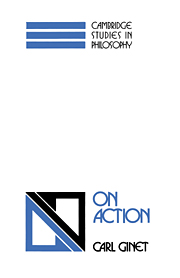Summary
What is it for a person to act? It is easy to give examples. I act when I voluntarily move my limbs, when I open a door, when I speak or write, press keys on the keyboard, slice a melon, or throw a ball, when I mentally say a word or mentally rotate a visual image. But not all events or states of which a person is the subject are actions. There are, for instance, perceptions, sensations, desires, beliefs, feelings, unbidden thoughts, faintings, sneezings, tremblings, reflex actions, and states of passivity. What distinguishes actions from these other sorts of things? What is the mark of action? Answering this question is not so easy.
REFORMULATING THE QUESTION
It is useful to have a standard way of referring (in English) to particular personal events and states, including actions. A suitable form of a singular noun phrase can be derived from any indicative active sentence that predicates of a person some event or state simply by changing the subject to its possessive form and changing the verb to the present participle. Thus the sentences “Sue suffered during the race” and “Tom started the engine five minutes ago” become, respectively, the singular noun phrases “Sue's suffering during the race” and “Tom's starting the engine five minutes ago”.
To be the canonical designator I want, such a noun phrase must pick out a particular personal event or state uniquely.
- Type
- Chapter
- Information
- On Action , pp. 1 - 22Publisher: Cambridge University PressPrint publication year: 1990



